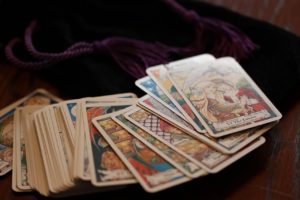(Quick heads-up before we start: this article contains some light spoilers for the endings to both The Light Fantastic and The Color of Magic.)
The Light Fantastic is the second book in Terry Pratchett’s Discworld series and the last before it splits off into several storylines whose variety has been the bane of any prospective reader lacking access to an easy Google search. It’s an absurdly hilarious read— I can’t overstate that, enough. They read like a novelized Monty Python Skit, but with real character and heart.
While the first book in the series was mostly a silly, well-written parody of the fantasy genre, there’s a distinct evolution in the second book. The characters have more depth and the trials and internal conflicts they face feel more “real,” grounded, and relevant to our world. The story moves away from being a simple parody and towards being a lovable novel in its own right, while still poking fun at ridiculous fantasy tropes in ways that often feel ahead of its time (Pratchett dedicates a full page and a half to tearing apart the “skimpy female armor” trope that still plagues modern gaming).
Terry Pratchett was a brilliant writer, and he’s got as many lessons to teach other writers as he does pages in his books. In this article, I’d like to explore Pratchett’s “commitment to the bit” in his worldbuilding, discuss why it works so well, and determine what other writers can learn from it. I’ve talked about this briefly in a previous article on long-distance communication, but I hope to explore it in more depth, here.
So, what do I mean by “commitment to the bit?” Well, in comedy, a “bit” is a take on reality or an overarching joke. When a character in a comedy takes everything too seriously, that’s his “bit.” “Commitment to the bit” is… well, just that. Committing to the bit over a long period of time, allowing that take on reality to affect your perspective, and following its logical train as long as possible.
Terry Pratchett could teach a friggin’ handful of masterclasses on this, but I want to highlight a pair of details that make him stand out: he carries every viable worldbuilding bit all the way to its conclusion, and makes those bits an important part of the story.
One golden example of this comes from the premise of the Discworld, itself. In the series, the Discworld is flat. Fully flat. Like, people have fallen off the edge. It’s how the first book ended. Anyway, the world is flat and floats through space carried on the backs of four elephants, who ride a giant turtle named Great A’Tuin. If that sounds ridiculous, it’s supposed to. It’s a comedy, remember?
So, that’s the bit. The world is carried by a giant turtle. Which is pretty funny, on its face. A bad writer would have stopped at that. They would’ve had their joke and called it a day, then moved on to the next cheap laugh. Terry Pratchett, on the other hand, weaves this single joke into the rest of his world. There are wizards dedicated to reading the mind of the turtle and figuring out what it’s moving towards, ships fall of the edge of the Discworld and disappear, that sort of thing. Terry Pratchett takes the time to think through all the logical consequences of his world being carried on the back of a turtle instead of using it as a cheap, one-off, absurdist laugh.
In fact, this detail is a salient part of the story.
In The Light Fantastic, the Great A’Tuin has begun drifting towards a hot red star in the middle of space. No-one knows why, and as our characters fumble around with their own issues and try to keep from getting killed, A’Tuin’s trajectory is noticed by more and more of the population and everyone becomes convinced the world is coming to an end. “Star cults” pop up, the weather gets hot, and our struggle to figure out what to do. Twoflower, one of the main characters, asks if anyone has taken the time to read A’Tuin’s mind to see where their world is going, only to be told that—being a turtle—A’Tuin’s mind works very slow, and wizards have been trying to read his mind in shifts for 30 years.
But, at the novel’s climax, we discover why A’Tuin was moving towards that hot red star: circling it are eight other orbs… which turn out to be turtle eggs. A spell is cast to hatch them and, with the brood in tow, A’Tuin turns around and leads them away from the star.
Which makes total sense. If we’ve got a giant space turtle, why not have giant space eggs around a celestial incubator? Pratchett took a single, silly bit from his story and allowed it to become a major (but not the major) plot point.
A’Tuin isn’t the only example of this. One character, Cohen the Barbarian, is an obvious parody of the famous “Conan the Barbarian.” His “bit?” He’s in his eighties, with back problems and a toothless mouth. But, it’s not just a joke. Cohen’s age is a relevant plot point whose consequences Pratchett explores. At no point—even at small asides where the characters have a snack—does Pratchett forget or allow the reader to forget that Cohen has back problems and a mouth full of gums, and these problems push the plot forward by giving him a goal (finding a set of teeth) or pulling him out of fights when his back gives out.
Funny as all this sounds, it keeps Pratchett’s worlds grounded and believable.
See, anyone can come up with a cheap, silly laugh. But, if your stories are filled with moments meant to do nothing more than net an easy giggle without a thought paid to the consequences of that storytelling choice, then your story falls apart. It might not be noticeable up-front, but the longer the story goes on, the more your readers roll their eyes, the more they start asking questions about the plot, and the more likely it is that the inconsistency pulls them out of the story. And, once out, they’ll stop to analyze it and realize that all these bits, while funny, vanished as soon as the writer stopped looking at them. The story turns into a handful of puzzle pieces that, while pretty and colorful on their own, don’t fit together in any way.
On top of that, considering the consequences of your “bits” can help you solve writer’s block and figure out how your story should develop; all you have to do is look at where you’ve moved your pieces and ask “with what I’ve made here, what’s going to happen next?” This isn’t just relevant to jokes. It’s relevant to worldbuilding in general. But, it’s something that’s easy to forget when you make story choices based on laughs or easy thrills.
I would strongly recommend picking up The Light Fantastic or one of the other books in the Discworld series, so you can see this sort of thought process in action. Happy writing!
Featured image courtesy of Tanguy Sauvin!



